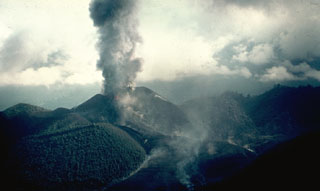Report on Carran-Los Venados (Chile) — December 1979
Scientific Event Alert Network Bulletin, vol. 4, no. 12 (December 1979)
Managing Editor: David Squires.
Carran-Los Venados (Chile) Fumarolic activity continues
Please cite this report as:
Global Volcanism Program, 1979. Report on Carran-Los Venados (Chile) (Squires, D., ed.). Scientific Event Alert Network Bulletin, 4:12. Smithsonian Institution. https://doi.org/10.5479/si.GVP.SEAN197912-357140
Carran-Los Venados
Chile
40.35°S, 72.07°W; summit elev. 1114 m
All times are local (unless otherwise noted)
Fumarolic activity has persisted from Mirador crater since its ash and lava eruption of April-May. A dense, yellowish-white steam cloud emerged from Mirador's summit during a visit by L. López, A. Lahsen, and H. Moreno on 1 November. The surfaces of two lava flows extruded on 12 May were covered by a yellowish salt deposit composed mainly of iron chlorides.
Geological Summary. The Carrán-Los Venados volcano group includes about 50 basaltic to basaltic andesite scoria cones, maars, and a small stratovolcano that are broadly aligned along a 17-km-long ENE-WSW trend ESE of Lago Ranco. The volcanic features occupy a low-lying area N of the more topographically prominent Puyehue-Cordón Caulle volcanic chain, and many of the vents are postglacial in age. The Mirador scoria cone and two maars, Riñinahue and Carrán, were formed during eruptions in the 20th century. These historical eruptions were concentrated where the regional Liquine-Ofqui fault zone intersects the alignment of volcanic vents.
Information Contacts: H. Moreno R., Univ. de Chile, Santiago.

